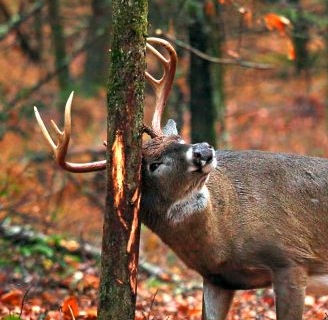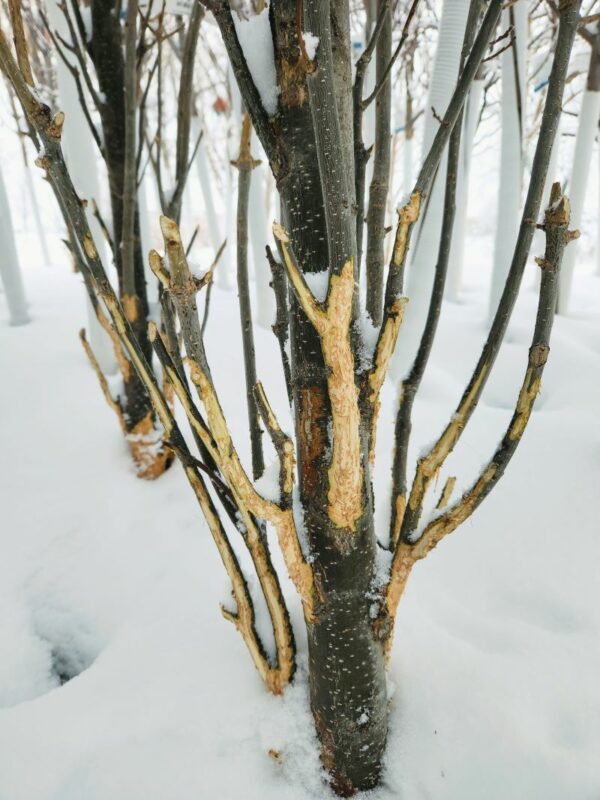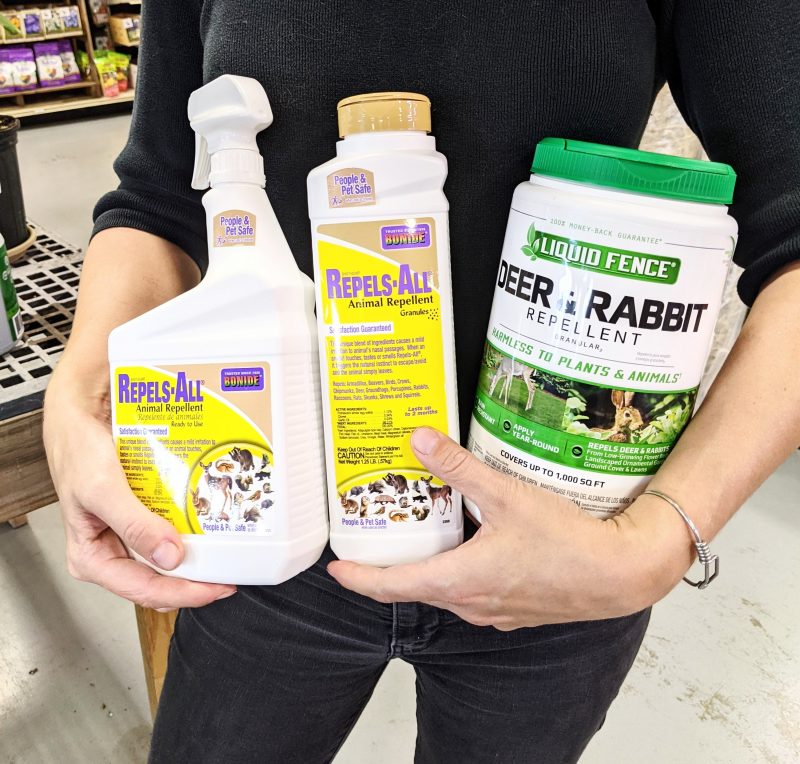
Animal Repellents and Plant Protection
We all love animals but sometimes they go where we don’t want them to or damage our landscapes and gardens. They can chew, eat, scratch, and damage plants throughout the year. When animals get hungry, they may not spare much. Protecting your plant investment is about protecting them from extensive damage that will severely stress or kill your plant. If you end up with a few bites are scratches, luckily your plants will be fine and will heal.
There are animal and human safe products available to repel mice, squirrels, voles, moles, raccoons, deer, and rabbits.
First we will look at what animal damage looks like so you know what you’re dealing with if you see it.
The two most common animals that damage our plants are deer and small rodents like rabbits and voles. Deer will rub against the bark and leave gashes (see main post image). They will even chew off the top of shrub branches.
Rodent damage will have cleaner cuts. Rabbits can chew down into the cambium layer of shrubs and trees and chew off small branches. It’ll look like a 45° angle cut as shown in the image above. The cambium layer is where water and nutrients are taken up. If the damage to the cambium layer goes around the entire branch or trunk, it will kill the plant and is called girdling. Voles can eat the roots of plants, bark, and dig tunnels that wreck lawn grass.
It’s important to reapply repellents as directed and after heavy snowfall. Make sure rabbits can’t get above the tree guards to nibble on the bark higher up the tree.
Scented Repellents
Various sprays and pelleted product contain scents and tastes that the animals are repelled by. The products contain all natural ingredients. They could contain clove oil, cayenne, peppermint oil, spearmint oil, putrefied egg, and possibly others. All of them are safe to use around your home and gardens.
Unfortunately, if animals are hungry enough, they will eat despite any offending smells that typically keep them away.
Animals can also get used to certain stinky smells. Alternate products that contain different ingredients to avoid them becoming used to the smell. Repellents will also need to be reapplied frequently and the frequency depends on the product instructions and weather.
When choosing between a spray or granular we do recommend getting both. Spray works best in the spring-fall and granular does better in the winter. Avoid spraying animal repellents on plants when the temps are below freezing.
Physical Barriers May Be the Best Bet
Install fencing or netting around your plants to prevent animals from accessing them. You can also use row covers to protect your plants from pests like insects and birds during the growing season.
One common physical protection for trees in the winter is a white plastic tree guard. They have two benefits. One is to prevent sun scald and frost cracks and the other is to protect tree bark from deer and rabbit damage. This is a great physical barrier to use every winter especially on young trees that have thin tender bark. There are also mesh tree guards to put around tree trunks that can be used year-round as they provide adequate air flow around the trunk. Those will not prevent winter weather damage.
If you use physical barriers, the snow may build up around them and allow animals to reach above the barrier. Dig out snow around the barrier if it’s creating a platform for the animals to perch and have a snack. * See image above of snow removed from around the tree trunk.
Covering your evergreens with burlap to prevent sunscald or winter burn during the winter will also help protect your evergreen from animal damage if they can’t dig under the burlap.
What To Do After the Damage Is Done
If a rabbit has eaten the entire cambium layer of a tree or shrub, the plant may be severely damaged and may not survive. However, here are some steps you can take to try to save the shrub:
- Prune the damaged area: Use sharp, clean pruning shears to remove any damaged or broken branches. This will help prevent further damage and allow the shrub to redirect its energy to healthier areas.
- Water: Give the plant plenty of water to help it recover. Make sure the soil around the plant stays moist but not waterlogged.
- Apply fertilizer: Apply a balanced fertilizer to the soil around the plant to provide it with the nutrients it needs to recover.
- Protect: Protect the plant from further damage by installing a fence or guard around it, or by using repellent sprays or other deterrents to keep animals away.
- Monitor: Keep a close eye on it and watch for signs of recovery. If the plant does not show signs of recovery after several weeks, it may be best to remove it and replace it with a new one.
Remember, the extent of the damage will depend on how much of the cambium layer was eaten and how quickly you take action. In some cases, the tree or shrub may be too damaged to save, and you may need to replace it with a new one.
If animals, like deer, ate some of the plant or chewed it down to a shorter height, the plant will survive if you follow the care steps above.
If you have an animal eat herbaceous perennials as they start growing in the spring, they can recover if they didn’t eat them all the way to the ground. Even if they did, it still may survive if it’s in it’s active growing period with a well-established root system.
Repel Mice and other Rodents from Nesting
You may have a barn, camper, boat, wood piles, sheds, decks etc. that you want to keep little critters like mice away during the winter and summer. There are repellents like Mouse Magic and Rat Magic that are safe to use around children and pets and won’t harm rodents or anything that eats them like some poisons do. They smell nice as well!
If you distribute the packs or granules around the areas that they may want to nest, along wall edges, and where they may enter, it should repel them away from those areas. If you have a lot of rodents, you may need to use more.
Rat Magic has a few more ingredients in it to help repel squirrels and chipmunks as well. Try sprinkling it around your garden if you have them digging up your bulbs or creating holes for their food stash.



